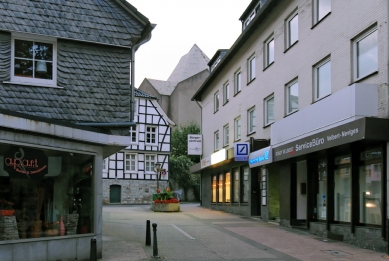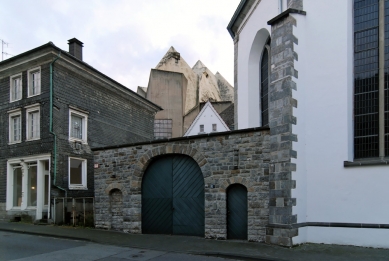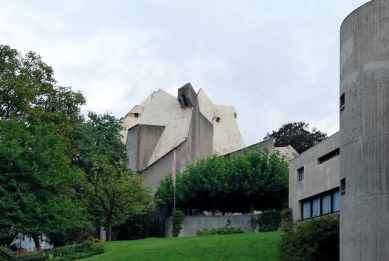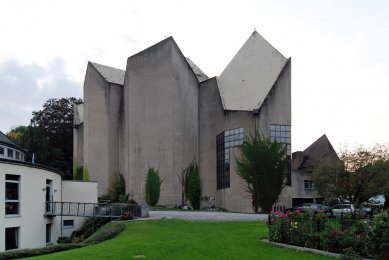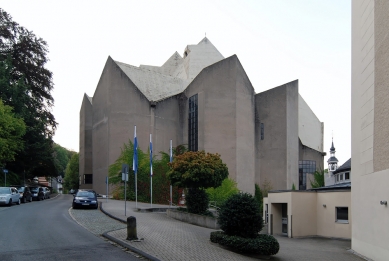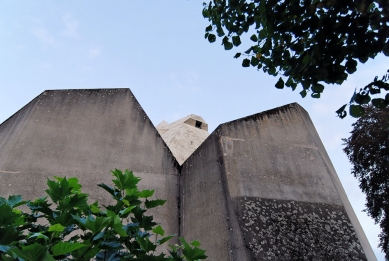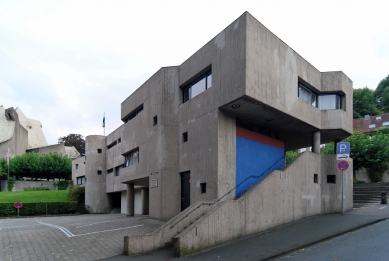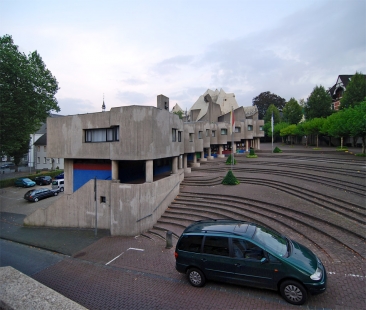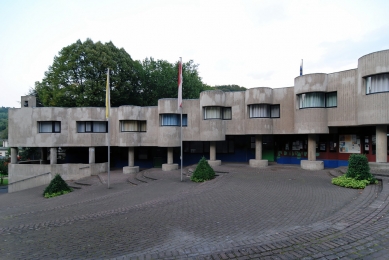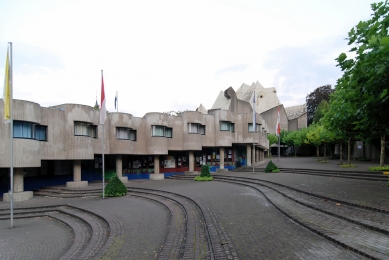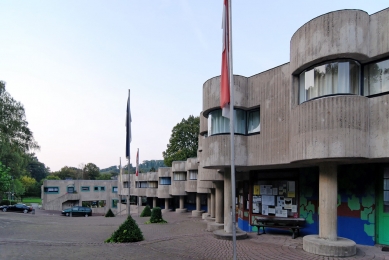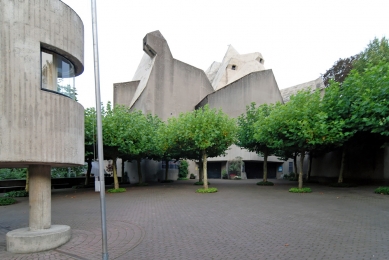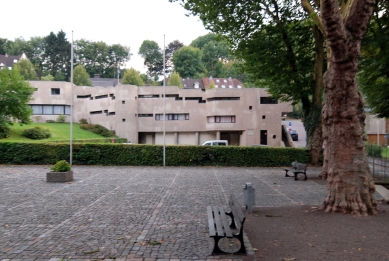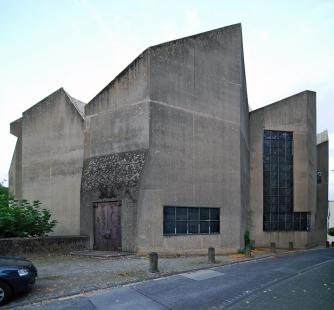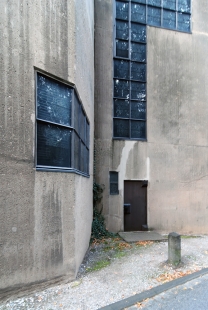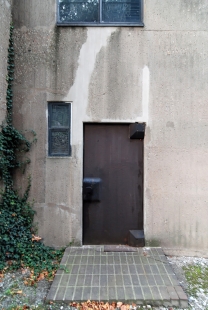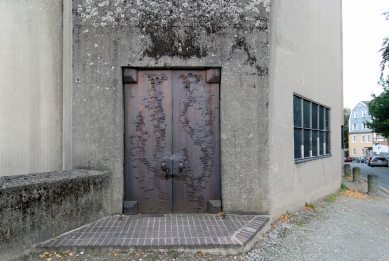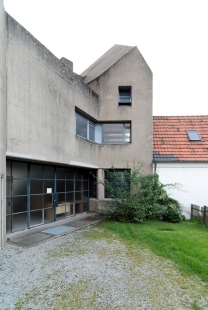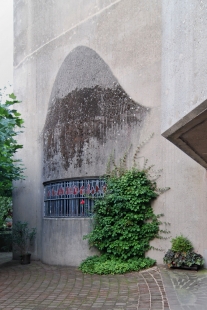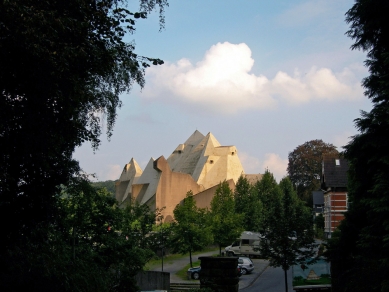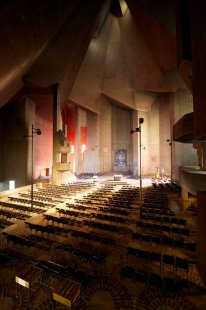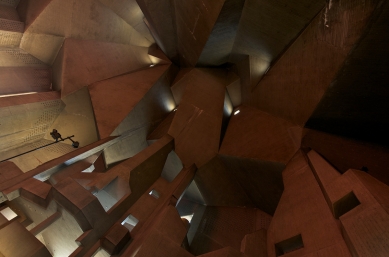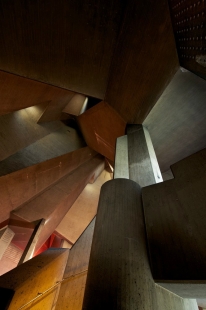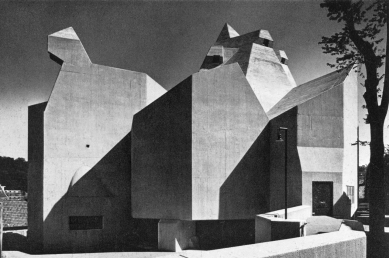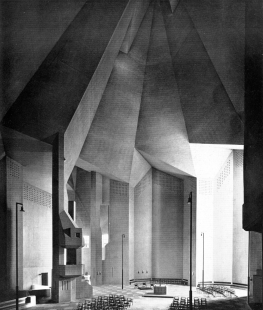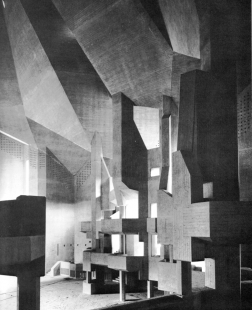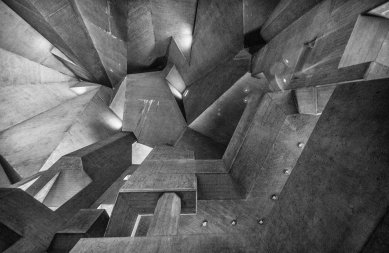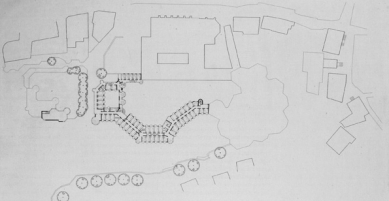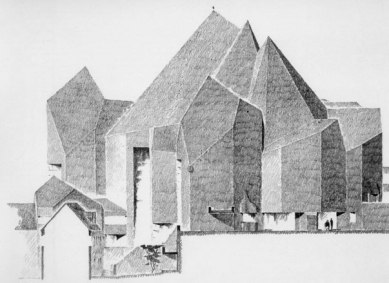
Mariánský kostel v Neviges translates to "Marian Church in Neviges"
Neviges Pilgrimage Cathedral

“Anyone who lacks the courage to sin does not have to be necessarily a saint or a good architect, but rather just boring.”
The town of Neviges is located five kilometers north of Wuppertal. The small historical center is hidden in the valley of the Hardenberger stream, surrounded by wooded hills. Neviges became a sought-after pilgrimage site when the Franciscan monk Anfonsi Schirley had a revelation of the Virgin Mary in 1676, who inspired him with the idea to go to Hardenberg Castle (on the hill above Neviges), where she was to be venerated.
When the Bishop of Münster, Ferdinand von Fürstenberg, recovered from a serious illness, he also made a journey to Neviges and paid the amount needed to complete the Franciscan monastery. In 1688, the General Vicar in Cologne and Pope Clement XII also approved spiritual pilgrimages to Neviges, promising all pilgrims the absolution of their sins. The number of pilgrims increased yearly until it exceeded 300,000 visitors in 1954, which the local church was not equipped to handle. Therefore, the Roman Catholic parish decided in 1960 to build a new Church of the Queen of Peace. Architect Gottfried Böhm, who had a strong spiritual story associated with the site, was invited, even though he did not win the architectural competition, he had the best qualifications (he was the son of Dominikus Böhm, who built the most sacred buildings in Germany in the first half of the last century, and together with Gottfried constructed eight churches. Moreover, after World War II, Gottfried Böhm closely collaborated with Rudolf Schwarz, who was the author of the most significant Catholic churches in Germany in the second half of the 20th century) and Cardinal Josef Frings advocated for his project. Böhm utilized the expressive means of modern architecture. The brutalist concrete forms (7,500 cubic meters of concrete and 510 tons of steel) carry a medieval spirit, and the unmistakable shape surprisingly fits into the confined historical environment. The construction of the massive reinforced concrete structure took only two years, and the church was consecrated on May 22, 1968, by Chinese Bishop Vitus Chang Tso-huan. The resulting shape may resemble a mountain range or a tent under which the faithful gather. The monolithic structure with a sandblasted surface has no additional thermal insulation or waterproofing, as it was only anticipated for seasonal use during summer pilgrimages. The layout of the interior was already based on the conclusions of the Second Vatican Council (1965). The flooring, which flows freely from the exterior into the church, and the presence of street lamps in the nave are meant to create a more familiar environment for individuals closer to the reformed church. With a capacity of more than 6,000 seats, the church is the second-largest sacred building in the local archdiocese after Cologne Cathedral.
Interestingly, Karol Wojtyła visited the church in Neviges in 1978 just three weeks before his election and appointment as pope. Unfortunately, the sad fact is that the pilgrimage church, founded in 1675, was abandoned by the Franciscans at the end of last year after 340 long years.
Gottfried Böhm
The town of Neviges is located five kilometers north of Wuppertal. The small historical center is hidden in the valley of the Hardenberger stream, surrounded by wooded hills. Neviges became a sought-after pilgrimage site when the Franciscan monk Anfonsi Schirley had a revelation of the Virgin Mary in 1676, who inspired him with the idea to go to Hardenberg Castle (on the hill above Neviges), where she was to be venerated.
When the Bishop of Münster, Ferdinand von Fürstenberg, recovered from a serious illness, he also made a journey to Neviges and paid the amount needed to complete the Franciscan monastery. In 1688, the General Vicar in Cologne and Pope Clement XII also approved spiritual pilgrimages to Neviges, promising all pilgrims the absolution of their sins. The number of pilgrims increased yearly until it exceeded 300,000 visitors in 1954, which the local church was not equipped to handle. Therefore, the Roman Catholic parish decided in 1960 to build a new Church of the Queen of Peace. Architect Gottfried Böhm, who had a strong spiritual story associated with the site, was invited, even though he did not win the architectural competition, he had the best qualifications (he was the son of Dominikus Böhm, who built the most sacred buildings in Germany in the first half of the last century, and together with Gottfried constructed eight churches. Moreover, after World War II, Gottfried Böhm closely collaborated with Rudolf Schwarz, who was the author of the most significant Catholic churches in Germany in the second half of the 20th century) and Cardinal Josef Frings advocated for his project. Böhm utilized the expressive means of modern architecture. The brutalist concrete forms (7,500 cubic meters of concrete and 510 tons of steel) carry a medieval spirit, and the unmistakable shape surprisingly fits into the confined historical environment. The construction of the massive reinforced concrete structure took only two years, and the church was consecrated on May 22, 1968, by Chinese Bishop Vitus Chang Tso-huan. The resulting shape may resemble a mountain range or a tent under which the faithful gather. The monolithic structure with a sandblasted surface has no additional thermal insulation or waterproofing, as it was only anticipated for seasonal use during summer pilgrimages. The layout of the interior was already based on the conclusions of the Second Vatican Council (1965). The flooring, which flows freely from the exterior into the church, and the presence of street lamps in the nave are meant to create a more familiar environment for individuals closer to the reformed church. With a capacity of more than 6,000 seats, the church is the second-largest sacred building in the local archdiocese after Cologne Cathedral.
Interestingly, Karol Wojtyła visited the church in Neviges in 1978 just three weeks before his election and appointment as pope. Unfortunately, the sad fact is that the pilgrimage church, founded in 1675, was abandoned by the Franciscans at the end of last year after 340 long years.
The English translation is powered by AI tool. Switch to Czech to view the original text source.
2 comments
add comment
Subject
Author
Date
Miluji Böhmovy kostely,
Vích
16.05.20 06:45
Miluji Böhmovy bunkry
Ivan Krátký
17.05.20 11:13
show all comments


